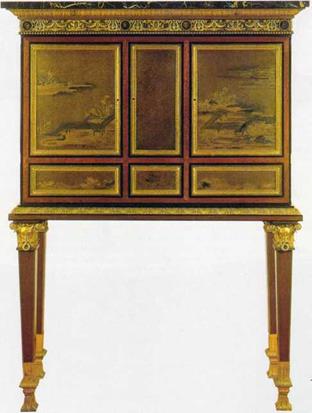|
I |
n the eighteenth century ordinary furniture was sold directly by the ebenistes, whereas luxury furniture was sold increasingly through the dealers, then called the ‘marchands-mcrciers’. The fashion begun by Boulle of decorating furniture with rich gilt – bronze mounts made its production very expensive. The <5b£nistes, who were always short of capital, gradually lost the initiative in the making of fine furniture, which eventually only marchands- mcrciers could afford to commission. The demands of a clientele avid for luxury and novelty were such that the dealers scarcely knew what to dream up next. Some, like Hebert, dismantled Japanese chests in order to take out the lacquer panels and apply them to new pieces of furniture. Others, like Poirier, had porcelain plaques made at Sevres to adorn certain small precious pieces. The role of the mer – ciers was therefore essential as they were involved in the design of furniture as well as its sale, and they invented combinations of materials and techniques that would have been impossible for the elxmistes themselves to imagine, hampered as they were by the restrictions of their guild.
The definition of the marchand-mercier according to the Encyclopedic. ‘dealers in everything – makers of nothing’, is no mere sally. Their statutes allowed them to sell everything, including imported goods, but forbade them to make anything themselves. Thence comes the term ‘marchand-mercier’ – a deliberate use of tautology, since ‘mercier’ derives from the Latin ‘mercator’, which also means

 ‘dealer’. This distinguished the marchands-merciers from the mar- chands-artisans (dealer-craftsmen). They handled a wide range of merchandise that included provisions, metalwork, fabrics and carpets. stationery, haberdashery (ribbons and braids), leather goods, jewellery and dressing-table accessories. Although not obliged under their statutes to do so. the merciers all specialized in certain goods. Three classes of merciers employed the eb£nistes. The most important were the marchands d’objets dart, who sold, according to Savary des Bruslons, ‘paintings, prints, candelabras, brackets, girandoles of bronze and gilt-bronze, crystal chandeliers, figures in bronze, marble, wood and other materials, clocks, time-pieces and watches; cabinets, coffers, armoires, tables, shelves and gu^ridons with bois de raport veneers and gilt wood, marble tables, and other pieces suitable for furnishing apartments.’ Most of the dealers mentioned hereafter belonged to this class. The marchands de miroirs specialized in toilet accessories and some, such as Delaroue. commissioned lavish pieces of furniture to match these articles (mirrors, chests and dressing-tables). The marchands-bijoutiers sold not only jewellery but porcelain and hard stones mounted in gilt-bronze, fire – dogs. candelabras and furniture. The word ‘jewel’ (bijou) was loosely used, and applied to anything precious whether furniture or object, so that the marchands-bijoutiers were generally synonymous with marchands d’objets d’art. Lazare Duvaux called himself bijoutier et joaillier’. Aubert. a former jeweller who had turned to dealing, sold furniture and porcelain as well as jewellery to the Comte d’Artois. Another marchand-bijoutier, Duchesne, who was established in 1791 in the rue de Richelieu at the sign ‘A la Couronne d’Or’, which he had taken over from Daguerre, sold bracelets as well as mahogany tables and clocks, as can be seen on a bill of purchase by the Duchesse d’Arenberg (see the illustration above right).
‘dealer’. This distinguished the marchands-merciers from the mar- chands-artisans (dealer-craftsmen). They handled a wide range of merchandise that included provisions, metalwork, fabrics and carpets. stationery, haberdashery (ribbons and braids), leather goods, jewellery and dressing-table accessories. Although not obliged under their statutes to do so. the merciers all specialized in certain goods. Three classes of merciers employed the eb£nistes. The most important were the marchands d’objets dart, who sold, according to Savary des Bruslons, ‘paintings, prints, candelabras, brackets, girandoles of bronze and gilt-bronze, crystal chandeliers, figures in bronze, marble, wood and other materials, clocks, time-pieces and watches; cabinets, coffers, armoires, tables, shelves and gu^ridons with bois de raport veneers and gilt wood, marble tables, and other pieces suitable for furnishing apartments.’ Most of the dealers mentioned hereafter belonged to this class. The marchands de miroirs specialized in toilet accessories and some, such as Delaroue. commissioned lavish pieces of furniture to match these articles (mirrors, chests and dressing-tables). The marchands-bijoutiers sold not only jewellery but porcelain and hard stones mounted in gilt-bronze, fire – dogs. candelabras and furniture. The word ‘jewel’ (bijou) was loosely used, and applied to anything precious whether furniture or object, so that the marchands-bijoutiers were generally synonymous with marchands d’objets d’art. Lazare Duvaux called himself bijoutier et joaillier’. Aubert. a former jeweller who had turned to dealing, sold furniture and porcelain as well as jewellery to the Comte d’Artois. Another marchand-bijoutier, Duchesne, who was established in 1791 in the rue de Richelieu at the sign ‘A la Couronne d’Or’, which he had taken over from Daguerre, sold bracelets as well as mahogany tables and clocks, as can be seen on a bill of purchase by the Duchesse d’Arenberg (see the illustration above right).
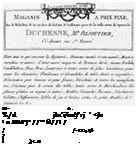
![]()
![]()
 The marchands-merciers were established not far from Les Halles, in the section of the rue Saint-Honord between the Palais – Royal and the streets leading to the Pont-Neuf (rue du Roule and rue de la Monnaie). Hebert. Dulac, de la Hoguette, Julliot. Lebrun. Bertin. Tuart and the most famous of them all. Poirier, as well as his successor Daguerre, were all in the rue Saint-Honore. Towards the Pont-Neuf. Lazare Duvaux. Calley and Damault were in the rue de la Monnaie; Bazin was in the rue du Roule and Boileau on the Quai de la M£gisscric. Finally, the dealer Granchez’s shop, at the sign of the ‘Petit-Dunkerque’, was by the exit from the Pont-Neuf. on the left bank of the Seine. Ebenistes who also wished to deal in furniture settled in the same quarter, between the Pont-Neuf and the I-ouvre. in order to attract the elegant clientfcle of the marchands-merciers: Boudin was in the rue Froidmanteau and later in the CloTtre Saint – Germain-l’Auxerrois; Genty in the rue de 1’Echelle; Joubert in the rue Sainte-Anne; Criard the Younger in the rue de Richelieu and later rue de Grenelle (now rue Jean-Jacques-Rousseau), and in 1781 Roentgen chose to establish his furniture business in the same street. Antoine Hericourt, famous in the mid-1780s, was established
The marchands-merciers were established not far from Les Halles, in the section of the rue Saint-Honord between the Palais – Royal and the streets leading to the Pont-Neuf (rue du Roule and rue de la Monnaie). Hebert. Dulac, de la Hoguette, Julliot. Lebrun. Bertin. Tuart and the most famous of them all. Poirier, as well as his successor Daguerre, were all in the rue Saint-Honore. Towards the Pont-Neuf. Lazare Duvaux. Calley and Damault were in the rue de la Monnaie; Bazin was in the rue du Roule and Boileau on the Quai de la M£gisscric. Finally, the dealer Granchez’s shop, at the sign of the ‘Petit-Dunkerque’, was by the exit from the Pont-Neuf. on the left bank of the Seine. Ebenistes who also wished to deal in furniture settled in the same quarter, between the Pont-Neuf and the I-ouvre. in order to attract the elegant clientfcle of the marchands-merciers: Boudin was in the rue Froidmanteau and later in the CloTtre Saint – Germain-l’Auxerrois; Genty in the rue de 1’Echelle; Joubert in the rue Sainte-Anne; Criard the Younger in the rue de Richelieu and later rue de Grenelle (now rue Jean-Jacques-Rousseau), and in 1781 Roentgen chose to establish his furniture business in the same street. Antoine Hericourt, famous in the mid-1780s, was established
in the rue Saint-Honore opposite the Hotel Montbazon. Finally. Sdverin was established in the rue de ГАгЪге-Sec and rue des Pretres-Saint-Germain-l’Auxerrois.

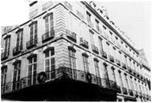 The principal marchands-merciers of the eighteenth century were the following:
The principal marchands-merciers of the eighteenth century were the following:
GERSAINT (died 1750). marchand-joaillier. was established on the Notre-Dame bridge. His first sign. 7u Grand Monarque’. Watteau’s famous painting now in Charlottenburg. reveals that he used to sell pictures as well as clocks with Boulle marquetry, consoles and mirrors. On the small trade label engraved by Boucher in 1740 there is a Chinese porcelain figure perched on a Chinese lacquer cabinet surrounded by shells, pictures and tea-sets. It reads: ‘At the Pagoda, Gersaint, marchand-joaillier on the Notre-Dame bridge, sells all kinds of new and tasteful metal-work, jewellery, mirrors, cabinet paintings, pagodas, lacquer and Japanese porcelain, shells and other items of Natural History, stones, agates and generally all kinds of interesting merchandise from abroad.’
THOMAS-joachim Hubert (died 1773), enjoyed the benefit of a special warrant as ‘marchand suivant la cour’ (dealer to the Court), known also as ‘marchand privi^ie du Palais’ (approved dealer to the Palace). At Versailles these dealers were established in the lower Galeries and on the staircases of the Chateau. In Paris Hubert had his shop first on the quai de la M6gisserie at the sign 7 Г Ecu de France’ and then in the rue Saint Honore. In 1745 he is mentioned as ‘marchand bijoutier. rue Saint Honore. vis a vis le Grand Conseif. He married in 1714 Louise Dezgodetz who died in 1724. and then Marie-Jeanne Legras who died in 1763. He was renowned during the years 1737 to 1750. when he supplied the royal family with all kinds of furniture in Chinese lacquer or vemis Martin as well as with porcelain, clocks and chandeliers. The £beniste to the King at the time was Gaudreaus. but the royal family preferred to use Hubert for any furniture out of the ordinary, and in particular for lacquer work, which seems to have been his speciality. It is probable that he was the first to have the idea of using panels of Japanese lacquer to decorate furniture; the oldest documented piece in Japanese lacquer is the commode stamped by В. V. R. B. which he supplied in 1737 for the private sitting-room of Marie Leszczynska at Fontainebleau. For ten years he alone supplied furniture of this type to the Crown, which suggests that he must have had something in the nature of an exclusive right. He gave work to the ebenistes В. V. R. B. and Criard. entrusting the former with furniture in Japanese lacquer and the latter with furniture in vernis Martin such as the pieces supplied in 1742 to Mile de Mailly at Choisy. In ten years, from 1737 to 1747. Hebert supplied more than forty sumptuous pieces of furniture to the royal family, including two commodes and a small bureau in Japanese lacquer, a dozen pieces in Chinese lacquer and the same
again in vemis Martin. In 1747 he supplied a suite of furniture in green vemis Martin to the daughters of Louis XV. The pieces with floral marquetry which he supplied in 1745 to the Dauphin and Dauphine were the first entries for floral marquetry, then a new fashion, in the day-book of the Garde-Meuble Royal. Hubert’s success was prodigious. On the occasion of his daughter’s marriage in 1751 to Dufour, the son of the first lady of the bedchamber to the Dauphine. the Due de Luynes noted in his memoirs:'(…] daughter of the celebrated H£bert, marchand to the court, who will have a large inheritance He seems to have retired at about this time, having in 1752 obtained the post of ’Conseiller secretaire du Roi. Maison, Couronne de France et de ses Finances’.
CLAUDE DELAROUE was established between 1746 and 1785 in the me de la Verrerie in a shop at the sign of ‘La Toilette Royale’. where he sold furniture, mirrors, fabrics and everything to do with toilette. His father and grandfather had been ‘lustriers du roi’. (makers of chandeliers to the King), a title kept by his brother Jere – mie and then his nephew until the Revolution. He himself was a marchand ordinaire, an ordinary dealer to the Court, and supplied the Garde-Meuble with chandeliers and girandoles as well as ebe – nisterie and meubles de toilette. He was purveyor to the Comte de Provence. (He supplied a jewellery-box in gilt wood and crimson velvet intended for the Comtesse de Provence on the occasion of their marriage in 1771.) He also supplied the Comte d’Artois with various meubles de toilette intended for Bagatelle or the Palais du Temple, including two commodes fitted with toilet accessories made by Dester, decorated with Paris porcelain plaques [378]. For Bagatelle he supplied a ‘table mobile’ which was both bureau and dressing-table, with marquetry in mosaic of blue wood and richly decorated with gilt-bronze mounts on a martial theme. For the boudoir of the Comtesse d’Artois at the Palais du Temple he supplied a writing-table in bois sating, decorated with tolework medallions painted with dancing figures in the classical style.
lazare DUVAUX (1703-58), son of a marchand bourgeois, was related to Thomas-Joachim Hebert and also to the great collector Louis-Jean Gaignat, who acted as a witness for him at his marriage in 1741. He entered the guild of marchands-merciers around 1740 and then, like Hubert, became ‘marchand suivant la cour’, dealer to the Court. Established first of all in the rue de la Monnaie, he moved to the rue Saint-Нопогё where he rented a house from Hebert and probably took over his business. (The high rental of6,000 livres for the building would suggest that Duvaux had taken over the entire establishment: furthermore, the period of Duvaux’s success covers the years 1748 to 1758, overlapping to a certain extent НёЬел whose name is not mentioned after 1752.) In 1755 Duvaux was appointed ‘orfevre-joaillier du roi’ (silversmith-jeweller to the King). On his death in 1758. he left a large stock, evidence of his pros
perity. The inventory (Arch. Nat. Min. Cent. XCIV/290) gives the names of his principal suppliers, including the 6benistes Joseph Baumhauer (credit of 1,726 livres); Jean-Frangois Dubut (credit of 62 livres); Pierre Macret (1.169 livres); the Martin brothers, lacquer – ers; the clock-makers Moisy, Etienne Lenoir, and various bronziers including Osmont, Paffe and Vassou. The day-book in which Lazare Duvaux registered all his commercial transactions between 1748 and 1758 (published by Courajod. new edition by de Nobele, 1965) gives the names of his clients and records the whole range of his business operations.
THE JULLIOT DYNASTY: CLAUDE-ANTOINE JULLIOT (died 1760); CLAUDE-FRANQOIS JULUOT (1727-94); PH1LIPPE-FRANQOIS JULLIOT (1755-1835). After 1739, the royal accounts mention ‘Jul – liot, jeweller/ as supplier to the Crown. In that year Claude-Antoine Julliot supplied a rock-crystal chandelier for the Petite Galerie at Versailles. In 1740 and 1741 he supplied numerous objects in Chinese porcelain, as well as fire-dogs, girandoles and Chinese lacquer furniture, to Versailles. These included two commodes, one for Versailles in 1740 and the other for the bedchamber of Mile de Mailly at Choisy in 1741, followed by two encoignures and two sets of corner shelves. In 1744 Julliot supplied a large bureau in amaranth decorated with six heads, of which two were of Bacchus, with escutcheons, handles, sabots and other gilt-bronze decoration.’ This piece was intended for the King, for the Cabinet des Tableaux adjacent to the Petite Galerie at Versailles. It is passible, as Daniel Alcouffe has suggested, that this was a bureau by Cressent. since several pieces of furniture by Cressent were in Julliot s sale in 1777. In 1752 Julliot was the expert in charge of the sale, which took place at the Tuileries. of Louis XIV’s cabinets in pietra-dura.
Son of Claude-Antoine Julliot. ‘marchand bourgeois de Paris’ and of a Mile F£vrier, Claude-Fran^ois Julliot married Marguerite Martin in 1753. At the time he is noted as a ’marchand-bijoutier’ on the quai de la Megisserie. The following were present at the wedding: the agent of the King of Prussia. Mathieu Petit de Rougemont, the marchand-bijoutier Antoine Hazon. the marchand-mercier Rochi – nel de la Planche. and the casters Jean-Fran^ois Prevost and Jean – Gabriel Dugu£. The groom’s assets were estimated at 6.000 livres.
While in the 1740s his father had specialized inchinoiserie. in the 1770s Claude-Fran^ois Julliot made a speciality of the resale of Boulle furniture. Between 1769 and 1789 he was one of the main buyers of this type of furniture at public auctions. During this period he also commissioned pastiches by the ebenistes Levasseur. Joseph Baumhauer and Montigny. In 1777 he supplied a commode by Levasseur for the bedchamber of the Comte d’Artois at the Palais du Temple. The same year, following the death of his wife, there was a sale of Julliot’s stock: besides some well-known pieces by Boulle. such as the coffers said to have belonged to the Grand
 Dauphin [ 14). there were pieces by Joseph Baumhauer and Levas – seur |244. 355). The inventory taken after the death of Mmc Julliot (Arch. Nat.. Min. Cent. X/666,5 November 1777) adds to the information given by the sale catalogue and confirms that the initiative in imitating Boulle furniture did indeed come from Julliot. There arc descriptions of stocks of bronze models copied from Boulle (masks, corner mounts, eagle-head escutcheons, fringes, zephyr-heads and various unidentified figures in bas-relief which must have been copied from the furniture in Julliot ’s stock, decorated with the Seasons or the legend of Apollo). The bronze models were catalogued as ‘models of ornaments in the style of Boulle suitable for bookcases’, or ‘models for commodes’ or ‘models for armoircs basses’, thus describing the three types of furniture which were a speciality of Julliot. The mention of’eight ribbons in relief and nine unchased medallions’ suggests that Julliot must have been making copies of famous armoires basses by Boulle with the figures of Aspasia and the Philosopher (32) decorated with medals. No doubt this was the origin of the pair of armoires from the Roudincsco Bequest (Versailles), which are stamped by Montigny and have medallions which are very obviously recast. In 1777 Julliot was established in the rue Saint-Honore near the rue du Four (now rue Vauvilliers). He seems to have retired at this time. When he died in 1794 he was living in a house which he owned in the rue des Deux-Ecus. The inventory made after his death (Arch. Nat.. Min. Cent. X/813) reveals that he no longer owned any stock of furniture or bronze mounts. His modest furnishing comprised a few pieces of furniture in mahogany or walnut. His assets amounted to 4.736 livres in cash and state bonds representing an annual income of 2.420 livres.
Dauphin [ 14). there were pieces by Joseph Baumhauer and Levas – seur |244. 355). The inventory taken after the death of Mmc Julliot (Arch. Nat.. Min. Cent. X/666,5 November 1777) adds to the information given by the sale catalogue and confirms that the initiative in imitating Boulle furniture did indeed come from Julliot. There arc descriptions of stocks of bronze models copied from Boulle (masks, corner mounts, eagle-head escutcheons, fringes, zephyr-heads and various unidentified figures in bas-relief which must have been copied from the furniture in Julliot ’s stock, decorated with the Seasons or the legend of Apollo). The bronze models were catalogued as ‘models of ornaments in the style of Boulle suitable for bookcases’, or ‘models for commodes’ or ‘models for armoircs basses’, thus describing the three types of furniture which were a speciality of Julliot. The mention of’eight ribbons in relief and nine unchased medallions’ suggests that Julliot must have been making copies of famous armoires basses by Boulle with the figures of Aspasia and the Philosopher (32) decorated with medals. No doubt this was the origin of the pair of armoires from the Roudincsco Bequest (Versailles), which are stamped by Montigny and have medallions which are very obviously recast. In 1777 Julliot was established in the rue Saint-Honore near the rue du Four (now rue Vauvilliers). He seems to have retired at this time. When he died in 1794 he was living in a house which he owned in the rue des Deux-Ecus. The inventory made after his death (Arch. Nat.. Min. Cent. X/813) reveals that he no longer owned any stock of furniture or bronze mounts. His modest furnishing comprised a few pieces of furniture in mahogany or walnut. His assets amounted to 4.736 livres in cash and state bonds representing an annual income of 2.420 livres.
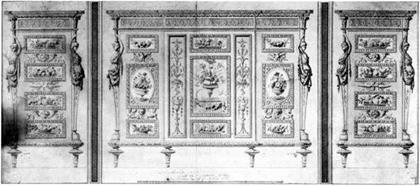
His son Phi I ippe-Francois, known as Julliot the Younger
(1755-1835). became a dealer during the 1780s. The inheritance from his mother in 1779 as well as various loans and gifts from his father in 1782 and 1787 helped him to establish himself. He took over his father’s shop at the sign of the ‘Curieux-des-Indes’ at the comer of the rue du Four and rue Saint-Honore. He conceived the idea of decorating furniture with panels of pietra-dura from large, dismantled, seventeenth-century cabinets. Л drawing (see p. 35) in the Musee des Arts D&oratifs, signed ‘Julliot Fils’ and dated 1784, is a sketch for a commode close to the one in Stockholm (4911. The few recorded pieces using this technique were stamped by Joseph. Carlin and Weisweiler. all ёЬёш81е$ who worked for Julliot or for Daguerre, the other dealer who also specialized in furniture in pietra-dura. Julliot the Younger was also expert in charge at the most important auction sales of the period: at the sale of the Due d’Aumont in 1782, then at the sale of Montribloud’s cabinet of curiosities in 1784, and finally at the Due de Richelieu’s sale in 1788. In other catalogues his name also appears as purchaser: in the Billy sale in 1784 he bought lot 175, a small secretaire, ‘decorated with four inlaid panels, in Florentine work’, which can be identified as the secretaire by Carlin recently acquired by the Louvre.
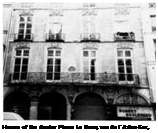 When his father died in 1794, Julliot was described as a *n£go – ciant, rue Jean-Jacqucs-Rousseau, no. 392’. In 1802 while he was in jail at Sainte-Pelagie, there was a sale of his stock, winding up the activities of the firm of Julliot. The catalogue describes several cabinets and one commode in pieta-dura, along with some ’old’ pieces by Boulle and many ‘in the genre of Boulle’. among them 28 low armoires. several cabinets, and pedestals of various shapes, some of which are described as unfinished’, which shows that the production of pastiche Boulle furniture was still very active around 1800. On his death in 1835 he was described as a ‘person of independent means living in Paris in the impasse Longe-Pierre near Saint-Jacques.’
When his father died in 1794, Julliot was described as a *n£go – ciant, rue Jean-Jacqucs-Rousseau, no. 392’. In 1802 while he was in jail at Sainte-Pelagie, there was a sale of his stock, winding up the activities of the firm of Julliot. The catalogue describes several cabinets and one commode in pieta-dura, along with some ’old’ pieces by Boulle and many ‘in the genre of Boulle’. among them 28 low armoires. several cabinets, and pedestals of various shapes, some of which are described as unfinished’, which shows that the production of pastiche Boulle furniture was still very active around 1800. On his death in 1835 he was described as a ‘person of independent means living in Paris in the impasse Longe-Pierre near Saint-Jacques.’
pierre lebrun (died 1771) was established in the rue Saint- Honore between the rue des Poulies and the Oratory, at the sign ‘Au Roi des Indes’. He was recorded as still being there in 1765. He later moved to a fine house in the rue de l’Arbre-Sec opposite the rue de Bailleul, where he lived until his death in 1771. The catalogue of the sale after his death, which took place on 18 November 1771. described the assets of his business: ‘paintings, drawings, prints, mounts, terracottas, marbles, different kinds of porcelain, interesting pieces of furniture by Boulle and other objects of curiosity which make up the business of the late Pierre Lebrun, painter of the Асж&тіе Saint-Luc. whose sale will take place in his house in the rue de I’Arbre-Sec, opposite the rue Bailleul. . .’ He was the father of Jean-Baptiste Lebrun, husband of the artist Mme Vigёe-Lebгun. Like his father before him. Jean-Baptiste Lebrun was an expert as well as an important buyer in the auction sales between 1776 and 1788. specializing in paintings and Boulle furniture. He used the

 considerable funds accumulated from his wife’s portrait-painting for his own business and commissioned the architect Raymond to build a large house on the rue du Sender in 1785. Fart of the house gave onto the rue de Оёгу and was used as a sale-room; its Boulle pastiche furnishings were supplied by Levasseur (3541. Bad management forced him to put his collections up for sale in April 1791.
considerable funds accumulated from his wife’s portrait-painting for his own business and commissioned the architect Raymond to build a large house on the rue du Sender in 1785. Fart of the house gave onto the rue de Оёгу and was used as a sale-room; its Boulle pastiche furnishings were supplied by Levasseur (3541. Bad management forced him to put his collections up for sale in April 1791.
darnault and His SONS. Established in the rue de la Monnaie at the sign ‘Au roy d’Espagne’. the business named ’Damault et Compagnie’ supplied the Garde-Meuble Royal from 1738 with various gilt-bronze wall-lights and lacquer etagfcres. During the 1750s Darnault often used the services of Joseph Baumhauer. as indicated by the presence of his business label on a lacquer commode in the J. Paul Getty Museum, a pair of commodes in the National Gallery of Washington and on a cartonnier in the Hermitage. He also used the services of Hansen, as confirmed by the label found on a commode en console in the Rosebery Collection (Ment- more sale. 18 May 1977, lot 141). In the 1780s the Damault sons employed Carlin and Levasseur and became the main suppliers to Mesdames, Louis XVI’s aunts, at their Chateau at Bellevue, supplying them with sumptuous furniture in Japanese lacquer (see pp. 344. 355).
SIMON-PHILIPPE POIRIER (c. 1720-85). son of a marchand – mercicr. in 1742 married the only daughter of mercier Michel Hece – g^re who was also the niece of the well-known Hebert. At the same time he was received into the guild of the Parisian marchands- merciers. The large dowries (12,000 and 13.500 livres) from the two families enabled the Poirier couple to join the Hecegufcre parents in the building occupied by them at 85 rue Saint-Нопогё ‘A la Couronne Dor’, opposite the Hotel d’Aligre. This partnership lasted until the death of H£cegu£re in 1753. The inventory of the business drawn up at that time gives the names of their clients, who included the Prince de Soubise (who owed 26.577 livres), the Prince de Сопс1ё, the Garde-Meuble Royal, the Duchesse du Maine, the Cardinal de Soubise, the Due de Duras, etc. Many £b£ni$tes were employed by Poirier-Hёcёguёre: B. V.R. B., Dubois the Younger. Dubut. Gamier. Joseph. R. V. L.C., Lhermite andTuart the Elder.
![]()
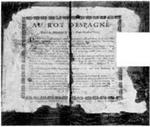 The size of the business is reflected in the high figures in the accounts: 27.088 livres in stock and 75,082 livres in credit. Later Poirier became one of the most important clients of the Sevres factory. Between 1758 and 1770 he bought almost 700,000 livres worth of porcelain. From 1760 he ordered porcelain plaques from Sevres to decorate furniture which he commissioned, first from В. V. R. B. and later from Joseph Baumhauer, R. V. L. C. and Carlin. Poirier had virtually a monopoly of these types of porcelain plaques from Sevres. Furthermore, almost all furniture with porcelain plaques made during this period passed through his hands. This rare and expensive furniture attracted a prestigious clientele. Between 1768
The size of the business is reflected in the high figures in the accounts: 27.088 livres in stock and 75,082 livres in credit. Later Poirier became one of the most important clients of the Sevres factory. Between 1758 and 1770 he bought almost 700,000 livres worth of porcelain. From 1760 he ordered porcelain plaques from Sevres to decorate furniture which he commissioned, first from В. V. R. B. and later from Joseph Baumhauer, R. V. L. C. and Carlin. Poirier had virtually a monopoly of these types of porcelain plaques from Sevres. Furthermore, almost all furniture with porcelain plaques made during this period passed through his hands. This rare and expensive furniture attracted a prestigious clientele. Between 1768
чпЛ 1774 he sold almost 100,(XX) livres worth of furniture to Mme du Barry. He also sold to the Duchesse de Mazarin. theComtesse d’Artois. the Comte de Provence, the Marquis de Marigny. and foreigners such as the Earl of Coventry and Horace Walpole. In 1772 Poirier took Dominique Daguerre, a cousin by marriage, as a partner and made over his business to him in 1777.
 DOMINIQUE DAGUERRE (c. 1740-96). cousin by marriage to Simon-Philippe Poirier, became almost an adopted son to the Poiriers. At the time of his marriage in 1772, he became involved in their business and was given a stock of gilt-bronze models as a gift. As we have seen, in 1777 Poirier made over to him the management of the whole business, which at the time was very successful, with credit amounting to 505.929 livres and liabilities of 286.497 livres. In the same year Poirier became an associate of Francotais. but this relationship lasted only until 1781. A comment in the L’Almanach general des marchands-negociants for 1779 recommends ‘Daguerre anti Francotais for fine furniture with French porcelain plaques.’ Like Poirier. Daguerre had made a speciality of furniture with Sevres porcelain plaques although the volume of his purchases of plaques from Sevres declined considerably after 1778. Daguerre entrusted his ebenisterie to Carlin until 1785. briefly to Schneider, and also to Saunier and Weisweiler. He also commissioned furniture in Japanese lacquer from the same 6b£nistes. The presence of identical bronze mounts on pieces made by these various ebenistes confirms that the bronze models did indeed belong to Daguerre. Daguerre also imported furniture from England, such as the two mahogany tables sold to the Comte d’Artois in 1779, and he reinterpreted the English styles in pieces such as the tea-tables which he had made by Weisweiler. He also had the idea of importing Wedgwood plaques from England (he had the sole agency in France from 1787) which he had mounted on small pieces of furniture made by Weisweiler. From 1777 he sold furniture to Mme du Barry (479). such as ‘a small table in burr-mahogany with cameos and glass top. the legs in cluster columns of bamboo in gilt-bronze. . . 720L’.
DOMINIQUE DAGUERRE (c. 1740-96). cousin by marriage to Simon-Philippe Poirier, became almost an adopted son to the Poiriers. At the time of his marriage in 1772, he became involved in their business and was given a stock of gilt-bronze models as a gift. As we have seen, in 1777 Poirier made over to him the management of the whole business, which at the time was very successful, with credit amounting to 505.929 livres and liabilities of 286.497 livres. In the same year Poirier became an associate of Francotais. but this relationship lasted only until 1781. A comment in the L’Almanach general des marchands-negociants for 1779 recommends ‘Daguerre anti Francotais for fine furniture with French porcelain plaques.’ Like Poirier. Daguerre had made a speciality of furniture with Sevres porcelain plaques although the volume of his purchases of plaques from Sevres declined considerably after 1778. Daguerre entrusted his ebenisterie to Carlin until 1785. briefly to Schneider, and also to Saunier and Weisweiler. He also commissioned furniture in Japanese lacquer from the same 6b£nistes. The presence of identical bronze mounts on pieces made by these various ebenistes confirms that the bronze models did indeed belong to Daguerre. Daguerre also imported furniture from England, such as the two mahogany tables sold to the Comte d’Artois in 1779, and he reinterpreted the English styles in pieces such as the tea-tables which he had made by Weisweiler. He also had the idea of importing Wedgwood plaques from England (he had the sole agency in France from 1787) which he had mounted on small pieces of furniture made by Weisweiler. From 1777 he sold furniture to Mme du Barry (479). such as ‘a small table in burr-mahogany with cameos and glass top. the legs in cluster columns of bamboo in gilt-bronze. . . 720L’.
During the 1780s Daguerre was the most famous dealer in Paris. Naturally all important visitors from abroad came to him. such as the Comte and Comtessc du Nord on their visit to Paris in 1782. The list of his clients spans the aristocracy (the Due de La Force, the Marcchale de Mirepoix, the Comte de Medavy, the Comtesse d’En – nery. the Baron de Breteuil, the Due d’Aiguillon) as well as bankers (Perregaux). the royal family and princes of the blood (Artois. Provence. Conde and Orleans). After 1785. when the Gardc-Meuble Royal stopped employing Riesener and used Benneman for its current needs, the finest furniture intended for the King or Queen at Versailles and Saint-Cloud was bought from Daguerre. When a present was required for one of her sisters, the Queen turned to him. Her correspondence with Mercy in 1786 mentions one of the royal
gifts: ‘I have asked the King. Sir. for the money which he is prepared to provide for the gift to my sister [Marie-Christine]. He is no more knowledgeable on the subject than I. but I do believe that a piece of furniture, decorated with nice mounts and above all with good lines. would be the best thing, and you can go to between 75 to 100 louis. I think that will repay, even with interest, for the King’s pleasure in the wretched boxes which my sister gave him (…) Daguerre came this morning and the oval table seems to me to be perfect. It is also the one which my sister preferred the day she went to the dealer.’ The Queen’s sisters. Maria-Carolina, Queen of Naples and Marie – Christine of Saxe-Teschen, Governor of the Austrian Netherlands, in their turn became Daguerre’s clients. It is probable that the latter ordered an important suite of furniture with porcelain plaques from him for her palace at Laeken. The only trace of this today is in a book of sketches in the Metropolitan Museum of Art (see p. 5 and the illustrations at left and right).
In 1789 Daguerre became associated with Martin-Eloi Lignereux and began to forge business links with England. He supplied furniture to the Prince of Wales, to the Duke of York. Lady Holderness. Lord Spencer and the Duke of Bedford at Woburn. In 1791 he put his stock from France up for sale at Christie’s. He died in 1794.
CHARLES-RAYMONDGRANCHEZ originally came from Dunkirk, where he had a shop at the sign of’La Perle d’Orient’. He became a marchand-mercier in 1767. and in that year established a second shop called the ‘Petit Dunkerque’ on the quai de Conti, at the entrance to the Pont-Neuf. In Dunkirk as well as in Paris. Granchez’s success came from the goods which he imported from England. Advertisements in L’Avant-coureur from 1767 to 1773. and then in the Mercure de France, reveal his growing success. In 1782 he had become one of the sights of Paris. Baroness d’Oberkirch who accompanied the Comtesse du Nord to Paris devoted a long passage to him in her memoirs: ’28th May. We spent the whole morning running around the shops. We spent several hours at the Petit Dunkerque. It’s the name of a jeweller on the approach to the Pont-Neuf. Nothing is so pretty or so gorgeous as this shop, filled with jewels and gold trinkets, which cost ten times the value of their materials. They sell at fixed prices and. even though the pieces are elegant and varied and the work exquisite, the dealer says that they are not expensive. And there are often so many people there that a guard is placed at the door. We chose the most fashionable piece, a little ornamental model of a windmill. Mme La Comtesse du Nord took a lot back to Russia with her.’ It is not known what course Granchez’s subsequent career took, but it is likely that the Revolution and the blockades that followed put an end to his trade with England.
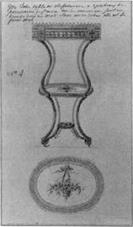
 In the creation of the fine furniture of the eighteenth century the role of the marchands-merciers was fundamental. At a time when most £b£nistes had neither the means nor the artistic talent to
In the creation of the fine furniture of the eighteenth century the role of the marchands-merciers was fundamental. At a time when most £b£nistes had neither the means nor the artistic talent to
undertake the finest pieces of furniture, the merciers. who rubbed shoulders with architects, decorators, and most importantly, with a demanding clientele, were constantly inventive. It was they who had the idea of marrying marquetry to precious materials; panels of Chinese or Japanese lacquer, porcelain plaques from Sevres or Wedgwood, tolework plaques imitating oriental lacquer, panels of pietra-dura or Boullc marquetry. They also invented many new types of furniture such as jewel-cabinets. the bonheur-du-jour or the secretaire en cabinet, and numerous kinds of tables. They adopted new styles as fast as the most daring of the ebenistes.
With the exception of works by Cressent. Doirat. Latz. Oeben. Gamier. Leleu and Riesener, almost all the finest furniture of the eighteenth century was the result of the imagination and commercial enterprise of the marchands-merciers. Given this situation, the £b£*niste appeared at the time to play a very secondary role, his talent being seen largely in craftsmanship of assemblage, the achievement of graceful curves and perfection of marquetry. It is therefore not surprising that ebenistes were described in contemporary records merely as ‘workers’. In an invoice dated 1774 submitted to Mme du Barry relating to a table by Carlin, which is now in the Louvre. Poirier described Carlin’s work as follows: ‘invoice, order and delivery note for a tea-table with porcelain plaques, commissioned from the workers and the Sevres factory.’ Л fine piece of furniture was often the work of a team with the eb£niste playing his part alongside the dealer who conceived the idea, the designer who created the form, the carver who supplied the bronze models, the bronzier who cast them, the craftsmen who chased and gilded them, and finally the lacquerer or the porcelain-painter who decorated the surface.

![]() Nowadays, believing as we do in the idea of individual creativity, it is hard to understand the phenomenon of collective production. For this reason and partly also because of the existence of stamps, the history of furniture-making has recorded above all the names of the ebenistes. For practical reasons this study is organized along the same lines and covers sixty-three of the great ebenistes. who practised from the early years of the reign of Louis XIV, from around 1660 onwards, up to the Revolution. We shall need to be aware of the limitations of such an approach.
Nowadays, believing as we do in the idea of individual creativity, it is hard to understand the phenomenon of collective production. For this reason and partly also because of the existence of stamps, the history of furniture-making has recorded above all the names of the ebenistes. For practical reasons this study is organized along the same lines and covers sixty-three of the great ebenistes. who practised from the early years of the reign of Louis XIV, from around 1660 onwards, up to the Revolution. We shall need to be aware of the limitations of such an approach.
![]()
|


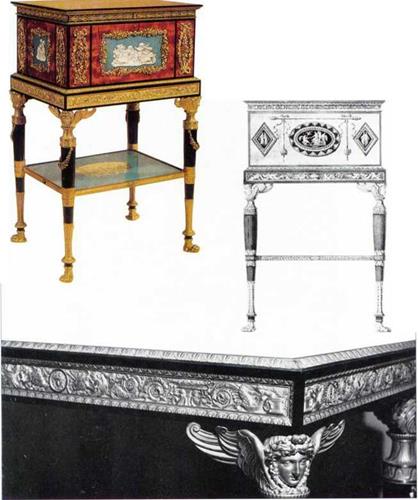 Design by J.-G. Sdoilte 11746-1810) for the jewel – cabinet made for William Bcchford; inscribed ‘diamantaire de Lord Bcchford’, it was made under the direction of Henry
Design by J.-G. Sdoilte 11746-1810) for the jewel – cabinet made for William Bcchford; inscribed ‘diamantaire de Lord Bcchford’, it was made under the direction of Henry
|
|
|
|||
